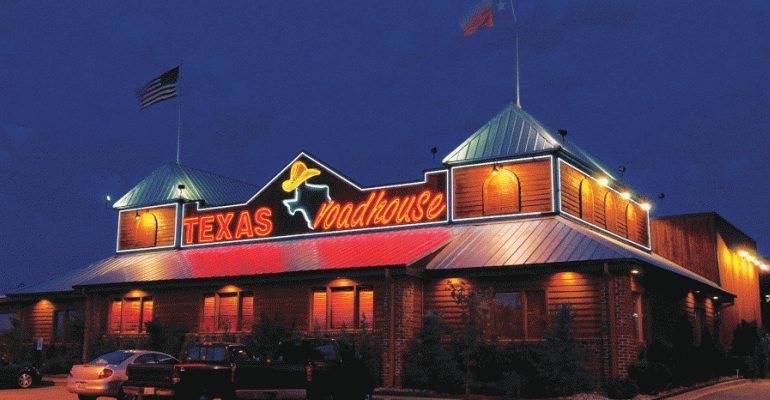Texas Roadhouse announced its Q4 earnings Thursday after market close, including a comp sales increase of 7.3% at company restaurants and 7.2% at domestic franchise restaurants. Average weekly sales in the quarter were just over $130,000, of which 12.6% were to-go sales. This is compared to just under $122,000 and 14.4% the year prior.
The biggest narrative from the earnings call, however, was traffic. Texas Roadhouse continues to generate positive traffic, despite many of its peers reporting negative trends. In Q4, traffic was up 1.1% for the chain, including a relatively “soft” December, according to executives on the call. That softness turned around swiftly to open 2023: The company’s first seven weeks of the year thus far are averaging weekly sales of $146,000, with comp sales up 15.8% compared to 2022. Some of those sales are coming from pricing and timing (lapping the Omicron variant), but as investor relations director Michael Bailen noted on the call, “we do not want to downplay our current results, our restaurants averaged more guests over the past seven weeks than in any period in our history.”
Of that 15.8%, 6% is coming from Q1 pricing, while “a tick over 10%” is flowing through traffic.
That history goes back exactly 30 years as of February 17. CEO Jerry Morgan said he’s excited about the demand for the concept, adding that 2022 marked the first time the company’s annual revenue surpassed $4 billion and he expects this momentum to continue.
“It was only five years ago when we exceeded $2 billion in revenue. We see the potential to double our revenue again over the next decade,” he said. “Despite inflationary pressures, our strong topline results helped us achieve significant growth.”
Executives expect those inflationary pressures to ease a bit this year, though beef, which is about 80% of the company's food basket, is forecasted to remain high. The company recently completed a 2.2% pricing increase, which Morgan said will help generate profit growth while maintaining value.
The company is also bullish on its labor picture. Executives noted that staffing levels have increased and are at the levels needed to manage higher volumes. This had added some wage inflation pressures, but those are expected to balance out through the duration of the year as retention numbers improve. That improved labor model is a critical component to maintaining positive guest counts, executives noted.
“Overall, we are happy with our current staffing numbers We’ve seen an increase and turnover is going down and we know the quality of people hired and retention is going to increase our productivity and that will help drive down our labor percentage, which is what we are working on right now,” said Gina Tobin, who was promoted to president in January. “As our staffing levels have come up and we get the tenure and people are more experienced, productivity goes up and they become more efficient and faster, all of that leads to stronger traffic.”
Throughout the past 12 months, retention rates have improved to the high 120s, versus mid-130s in mid-2022. Pre-pandemic, the company was in the 105-to-110 range.
Executives also pointed to technology deployments as drivers of some traffic lifts. For instance, Roadhouse Pay, where customers can pay at their table without waiting on a server, is now live in 615 restaurants and enables restaurants to turn tables faster. Kitchen Display Systems have been added to some restaurants and are speeding up ticket times.
“We look at, from a tech standpoint, any piece that can help speed, which obviously increases traffic growth,” said Tobin.
Texas Roadhouse will leverage its sales and traffic growth to continue adding to its footprint, which is currently about 700 restaurants. In Q4, 10 company restaurants were opened and 25 to 30 new Texas Roadhouse units are projected for 2023. Notably, executives said they’ll continue to look for “tried and true” suburban real estate that has worked for the brand throughout the past 30 years, but will also start to look more in higher-traffic metropolitan areas.
“We do have a restaurant in New York City and New Rochelle (New York) that we’ve looked at and … have had some success in lower-populated, smaller areas,” said interim CFO Keith Humpich. “So, we are expanding a little bit. For a company our size and what we want to accomplish, we have to try some new things. We have opened the scope of what we will try so we can expand and have success and that may look a little different than what we’ve done in the past.”
Contact Alicia Kelso at [email protected]





